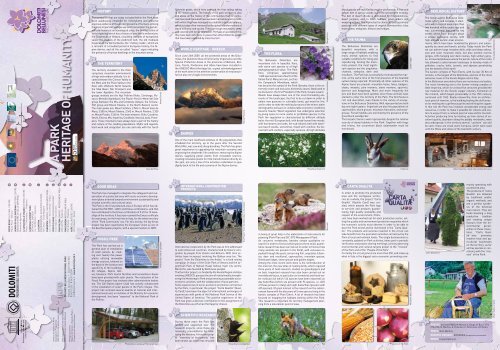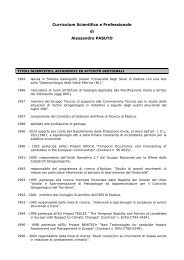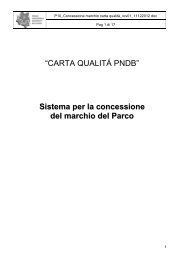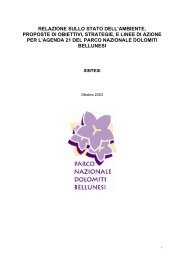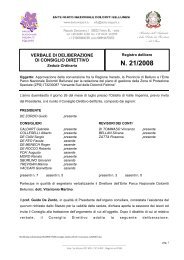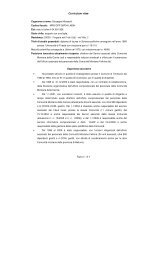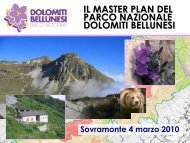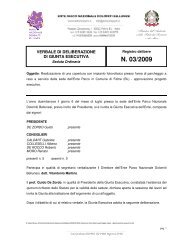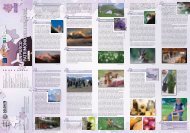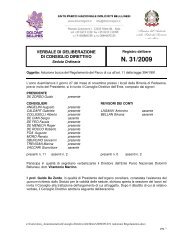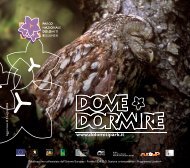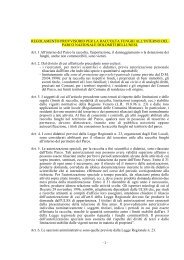Institutional Brochure - Parco Nazionale Dolomiti Bellunesi
Institutional Brochure - Parco Nazionale Dolomiti Bellunesi
Institutional Brochure - Parco Nazionale Dolomiti Bellunesi
You also want an ePaper? Increase the reach of your titles
YUMPU automatically turns print PDFs into web optimized ePapers that Google loves.
REGIONE DEL VENETO<br />
FEASR<br />
The European Agricultural Fund for Rural Development: Europe investing in rural areas<br />
HISTORY<br />
The territories that are today included within the Park have<br />
been assiduously inhabited for millenniums and preserve<br />
precious evidence of the ancient presence of humans. Among<br />
the most important vestiges we must remember the numerous<br />
pre-historical archaeological sites; the mining centre of<br />
Valle Imperina, which has a history of over half a millennium;<br />
the Chartreuse of Vedana, a building complex of exceptional<br />
value; the chapels of the piedmont belt; the old medieval<br />
hospices of the Val Cordevole; the “military roads”, which are<br />
a remnant of a troubled period in European history; the Alpine<br />
dairies, and all the so-called “lesser” signs indicating<br />
the presence of human dwellings in the mountain areas.<br />
THE TERRITORY<br />
The territory included in the Park<br />
comprises mountain environments<br />
of high and medium altitude. It is located<br />
between the Cismon Valley to<br />
the West and the Piave Valley to the<br />
East; with offshoots North towards<br />
the Maè Basin (Val Prampèr) and<br />
the lower Agordino. The mountain<br />
groups involved are the Alpi Feltrine (Vette, Cimónega, Pizzocco-Brendòl-Agnelézze),<br />
the Pizzón-Ferúch-Monti del Sole<br />
group (between the Mis and Cordevole Valleys), the Schiara-<br />
Pelf group and Mount Talvéna, in the North-Eastern sector.<br />
The main peaks are: Mount Schiàra, 2.565 m, Mount Sass de<br />
Mura, 2.550 m, Mount Talvéna, 2.542 m, Mount Pavióne, 2.335<br />
m, Mount Pizzón, 2.240 m. The main streams: Stién, Caoràme,<br />
Vesés, Falcìna, Mis, Imperìna, Cordévole, Vescovà, Ardo, Prampèra.<br />
These mountains have always been a part of the history<br />
and culture of the residing populations. Myths and legends,<br />
hard work and emigration are one and only with the harsh<br />
Sass de Mura<br />
Monte Fornèl<br />
Dolomite peaks, which here overlook the first valleys taking<br />
to the Veneto plains. The history of the park territory is also<br />
and above all the history of the communities that for centuries<br />
have lived there and have worked in a hostile environment,<br />
with which they have managed to establish a delicate balance,<br />
which is today often menaced by the global transformations of<br />
world economy and society. These are tough mountains, steep<br />
and covered with dense vegetation. Perhaps on account of this<br />
they have been left more in peace than other Dolomite peaks<br />
that have been exploited by mass tourism.<br />
WORLD HERITAGE - UNESCO<br />
Since June 26th 2009, all the protected areas of the Dolomites,<br />
the Dolomite Sites of Community Importance and the<br />
Special Protection Areas in the provinces of Belluno, Bolzano,<br />
Trento, Pordenone and Udine have been included in<br />
the UNESCO World Heritage list: a great acknowledgement<br />
of the work done in the attentive conservation of very beautiful<br />
but also very fragile environments.<br />
DAIRIES<br />
One of the main livelihood activities of the populations that<br />
inhabited this territory, up to the years after the Second<br />
World War, was cow and sheep breeding. The Park has given<br />
great importance to upgrading the mountain economy and<br />
improving the shepherds’ life conditions: restoring the Alpine<br />
dairies, supplying power plants from renewable sources,<br />
creating innovative plants for milk transformation directly on<br />
the spot, are only a few of the activities undertaken to give<br />
dignity back to the life and economy of the Alpine dairies.<br />
Monte Pizzocco<br />
THE FLORA<br />
The Bellunese Dolomites are<br />
mountains rich in beautiful flora,<br />
with some rare species or of high<br />
phytogeographical value. The Park<br />
flora comprises approximately<br />
1.400 species (almost a fourth of the<br />
Italian flora). Many are rare, such as<br />
the Campanula Morettiana, which<br />
has become the symbol of the Park. Besides, there is the extremely<br />
recent and exclusive Alchemilla lasenii (dedicated to<br />
its discoverer, the first President of the Park, Cesare Lasen).<br />
Woods have always been one of the most fluctuating elements<br />
of the landscape, the first to be cut down in order to<br />
obtain new pastures or cultivable lands, get wood for fire,<br />
and in order to stoke the melting furnaces of the mines, when<br />
demographic pressure or unfavourable economic conditions<br />
became heavier. Wood vegetation has undergone selection<br />
by giving space to more useful or profitable species. In the<br />
Park the vegetation is characterized by different altitude<br />
belts: the mid-European belt, with broad-leaved tree woods,<br />
with hornbeams and oaks; the sub-Atlantic belt with extensive<br />
beech woods, sometimes mixed with conifers; the boreal<br />
belt with conifers, especially spruces. At high altitudes<br />
Paradisia liliastrum<br />
Malga Erera<br />
Campanula morettiana<br />
beech woods are replaced by mugho-pine woods. A true and<br />
proper belt of spruce woods is almost everywhere missing.<br />
The belt of dwarf shrubs is dominated by rhododendrons,<br />
dwarf junipers, and, in fresh habitats, green alders and<br />
weeping willows. The Alpine belt is characterized by primary<br />
pastures with different types of vegetal communities: blue<br />
moor grass, matgrass, festuce and sedges.<br />
THE FAUNA<br />
The Bellunese Dolomites are<br />
beautiful mountains, with a<br />
large range of habitats enabling<br />
many animal species to find<br />
suitable conditions for living and<br />
reproducing. Among the mammals<br />
present, the most significant<br />
species are the ungulates:<br />
chamois, roebucks, deer and<br />
mouflons. The Park has successfully reintroduced the marmot,<br />
at the same time of the first presence of the bearded<br />
vulture being reported. Practically all other species of the<br />
Alpine fauna are present: mountain hares, foxes, badgers,<br />
stoats, weasels, pine martens, stone martens, squirrels,<br />
dormice and hedgehogs. More and more frequently the<br />
lynx and bear have been spotted, since these animals have<br />
started to enter the territory of the Park. The bird fauna is<br />
rich and diversified, even thanks to the variety of ecosystems<br />
in the Bellunese Dolomites. Well represented are both<br />
day and night raptors. Important are also the populations of<br />
capercaillies, black grouse, mountain francolins, and snowgrouse.<br />
Forest habitats are enriched by the presence of the<br />
great black woodpecker.<br />
The herpetic fauna is well represented, despite the relative<br />
scarcity of damp habitats in the Park. Together with frogs<br />
and tritons, the uncommon black salamander must be<br />
mentioned.<br />
Chamois<br />
Golden eagle<br />
GEOLOGICAL HISTORY<br />
The history of the Bellunese Dolomites<br />
is long and complex. It started<br />
in warm tropical seas more than<br />
two hundred million years ago and<br />
was successively featured by key<br />
events which have brought about<br />
a unique geological variety, with<br />
high altitude karstic-nival environments,<br />
which have been modelled by glaciers and subsequently<br />
by snow and karstic activity. Today inside the Park<br />
we can admire large meadow dells, wide and deep valleys,<br />
vast and solar mountain walls, but also sombre narrow<br />
gorges, cliffs hanging over dark ravines, high solitary gorges,<br />
tormented plateaus where the karstic nature of the rocks<br />
has allowed a subterranean landscape to develop made of<br />
potholes, cracks, halls, tunnels, and abysses penetrating<br />
into the bowels of the earth.<br />
The karstic complex of Piani Eterni, with its over 30 Km of<br />
tunnels, is the largest of the Dolomites, and one of the most<br />
extensive caves in the Veneto Region and in Italy.<br />
In the Bellunese mountains there are numerous ore bodies.<br />
The most interesting one is the former mining complex of<br />
Valle Imperina, which for at least five centuries provided the<br />
raw material for the Veneto copper industry. Extraction of<br />
the mineral, which began presumably in the 15th century,<br />
continued until 1962. Really noteworthy, from an architectural<br />
point of view too, is the building hosting the old furnaces<br />
for melting the cupriferous pyrite and refining the copper.<br />
In this site the Park has invested considerable energy and<br />
resources, in order to make it possible for citizens and visitors<br />
to enjoy it from a cultural point of view and for tourism.<br />
Activities producing lime by heating up lime stones of excellent<br />
quality, abundant along the pebbly riverbanks, were<br />
also widespread. In the territory several “calchere” can still<br />
be seen: these are small stone furnaces, which were used<br />
until the fifties and sixties of the twentieth century.<br />
Valle Imperina. Inside the melting furnaces<br />
The Cadini del Brenton<br />
PIERO ROSSI CULTURAL CENTRE<br />
Piazza Piloni - Belluno<br />
UOMINI DI VALLE IMPERINA VISITORS CENTRE<br />
MINING CENTRE OF VALLE IMPERINA<br />
Rivamonte Agordino<br />
IL SASSO NELLO STAGNO VISITORS CENTRE<br />
Piazza 1° Novembre, 1 - Pedavena<br />
CAMPANULA MORETTIANA<br />
BOTANICAL GARDEN<br />
Loc. Val Brenton - Sospirolo<br />
LA SANTINA<br />
ENVIRONMENTAL EDUCATION CENTRE<br />
Val Canzoi - Cesiomaggiore<br />
CANDÀTEN CAMPER - REFRESHMENT AREA<br />
Loc. Candàten - Val Cordevole - Sedico<br />
CROCE D’AUNE INFORMATION POINT<br />
Croce d’Aune - Sovramonte<br />
Initiative funded by the Rural<br />
Development Programme<br />
2007-2013 for the Veneto, Axis 4 - Leader<br />
PIAN FALCINA CAMPER - REFRESHMENT AREA<br />
Valle del Mis - Sospirolo<br />
PIAN D’AVENA REFRESHMENT AREA<br />
Pian d’Avena - Pedavena<br />
AGRE VOLUNTEERS’ CENTRE<br />
Val Cordevole - Sedico<br />
DOLOMITI BELLUNESI NATIONAL PARK<br />
Piazzale Zancanaro, 1 - 32032 Feltre (BL)<br />
T 0439 3328 - F 0439 332999<br />
info@dolomitipark.it - www.dolomitipark.it<br />
Body responsible for the information:<br />
<strong>Parco</strong> <strong>Nazionale</strong> <strong>Dolomiti</strong> <strong>Bellunesi</strong><br />
Managing authority:<br />
Regione del Veneto – Direzione Piani e<br />
Programmi del Settore Primario<br />
GOOD IDEAS<br />
The Park has managed to integrate the safeguard and conservation<br />
of a protected area with socio-economic development<br />
plans oriented towards environment sustainability and<br />
of great scientific and cultural value.<br />
The Park is the first protected area in Europe which has obtained<br />
the ISO 9001-14001 and Emas certifications, and that<br />
has contributed to the Emas certification of 5 of the 15 townships<br />
of the territory. It has also received the Emas certificate<br />
for vast areas, for the first time in Italy, for the whole territory<br />
of the “Park Community” too. For this activity, the Ag-Emas<br />
project has been reported by the European Union as one of<br />
the best European projects, with a special mention in 2009.<br />
FOSSIL FREE<br />
The Park has carried out a<br />
general plan of installation<br />
of solar panels, by creating<br />
over twenty five power<br />
plants utilizing renewable<br />
energy sources, tailored on<br />
the basis of the location and<br />
specificity of the buildings.<br />
All refuges, Alpine dairies,<br />
bivouacs, Park tourist facilities and surveillance bases<br />
have been provided with solar plants. The realization of the<br />
Fossil Free project has involved other administrative bodies<br />
too. The CAI (Italian Alpine Club) has actively collaborated<br />
in the installation of solar panels in the Park refuges. This<br />
project has received several awards at national and international<br />
levels and, on initiative of the Ministry for economic<br />
development, has been “exported” to the National Park of<br />
the Pollino.<br />
Photovoltaic canopy at Park premises<br />
Photovoltaic roof at Candàten<br />
INTERNATIONAL COOPERATION<br />
PROJECTS<br />
International cooperation by the Park was at first addressed<br />
to Latin American countries, characterized by historic emigration<br />
by people from Veneto and Belluno. With time activities<br />
have increased, involving the Balkan area too. The<br />
project “from the Dolomites to the Andes” is a fund raising<br />
campaign in favour of the Chile Park of Omora and the Argentinian<br />
Park of Nahuel Huapi (whose main city centre,<br />
Bariloche, was founded by Bellunese people).<br />
The Durmitor project, co-funded by the Veneto Region and also<br />
involving UNESCO, pursues the aim of institutionally strengthening<br />
the Montenegrin Park and promoting sustainable socioeconomic<br />
activities, with the collaboration of local partners.<br />
Some experiences of socio-economic promotion carried out<br />
by the Park, in particular the project “Carta Qualità” (Quality<br />
Card), have been the object of international exchanges of<br />
experiences with parks of the National Park Service of the<br />
United States of America. The positive experience of the<br />
Park has given a decisive contribution to the assignment of<br />
the Dolomites as a Human Heritage by Unesco.<br />
SCIENTIFIC RESEARCH<br />
During these years the Park has<br />
funded and supported over 150<br />
research projects, since these are<br />
necessary preconditions for managing<br />
the territory. A true and proper<br />
“inventory of biodiversity” has<br />
been drawn up, which has resulted<br />
The Project “from the Dolomites to the Andes”<br />
Great black woodpecker<br />
in being of great help in the elaboration of instruments for<br />
planning (Park Plan and SIC-ZPS Management Plan).<br />
As concerns vertebrates, besides simple qualitative research<br />
(in order to find out what species there exist), quantitative<br />
research has been carried out (in order to find out how<br />
many animals are present in the Park), with censuses repeated<br />
through the years concerning fish, ungulates (chamois,<br />
deer and mouflons), capercaillies, mountain grouse,<br />
Greek partridges, snow-grouse and golden eagles.<br />
Among the most recent work done is the reintroduction of<br />
the marmot, the new atlas of nesting birds, which required<br />
three years of field research, studies on grasshoppers and<br />
on bats. Important research has also been carried out on<br />
invertebrate fauna, in particular on terrestrial and fresh water<br />
molluscs (of which 134 species have been reported); on<br />
day butterflies (which are present with 96 species, i.e. 40%<br />
of those present in Italy) and night butterflies (present with<br />
435 species). Of great interest is the research on the subterranean<br />
fauna with the discovery of 5 new species living in the<br />
karstic complex of Piani Eterni. A lot of research has been<br />
focused on mapping the habitats existing within the Park.<br />
This research is important for territory management planning<br />
from a naturalistic point of view.<br />
Fox<br />
Marmots<br />
CARTA QUALITÀ<br />
In order to promote the protected<br />
area and the contiguous territories<br />
as a whole, the project “Carta<br />
Qualità” (Quality Card) was created,<br />
which awards the Park logo<br />
to services and products guaranteeing<br />
high quality standards and<br />
respect of the environment. Protocols<br />
have been worked out for each productive sector, setting<br />
the quality and environment protection requisites which<br />
the economic activity must observe in order to be able to<br />
bear the Park brand and be mentioned in the “Carta Qualità”.<br />
The products and services inserted in the circuit can<br />
take benefit from the promotion activities carried out by the<br />
Park at local and national levels. The single businessman is<br />
constantly updated on Park activities, takes part in periodic<br />
verification and project sharing meetings, joins by observing<br />
environmental and cultural targets proper to the “mission”<br />
of the Park and of the “People of the Park”.<br />
Currently the circuit joiners are more than 250, and make up<br />
what in Italy is the biggest socio-economic promoting com-<br />
Products of the Park<br />
Mountain dairy cheese<br />
“L’Om Selvàrech”<br />
munity operating with<br />
a protected area.<br />
The products of “Carta<br />
Qualità” are obtained<br />
by traditional and/or<br />
organic methods, and<br />
are a perfect synthesis<br />
of the binomial<br />
man-nature. They are<br />
foods boasting a long<br />
productive tradition<br />
and creating unique<br />
flavours from the environmental<br />
peculiarities<br />
of these mountains.<br />
“Carta Qualità”<br />
also promotes<br />
modern food and agricultural<br />
businesses<br />
on the territory, as far<br />
as they operate in consistency<br />
with the “mission”<br />
of the Park.<br />
PHOTOS: Archives PNDB, M. Minute, A. Borgo, B. Boz, F. Friz<br />
CTA-CFS, N. Martino, G. Poloniato, E. Vettorazzo, CAI Feltre.<br />
TEXTS: Nino Martino<br />
GRAPHIC PROJECT: EVIDENZIA immagine&comunicazione<br />
PRINT: Linea Grafica srl<br />
Chair maker at work
PARK LODGE<br />
CULTURAL CENTRE “PIERO ROSSI”<br />
KEY TO SYMBOLS<br />
“AL FRÀSSEN” HOUSE<br />
Loc. Fràssen - Val Canzói - Cesiomaggiore<br />
T 0439 42723 - C 329 0040808<br />
frassen@dolomitipark.it - www.dolomitipark.it<br />
3 bedrooms (5+5+12 beds), 5 bathrooms<br />
In Val Canzói, in the heart of the Park, at the start of the tracks<br />
leading to two of the most extraordinary places in the Bellunese Dolomites,<br />
the Erèra plateau and the Cimónega dell, there is a lodge<br />
called “Al Fràssen”. An old rural house, bought and restored by the<br />
Park, has become a cosy lodge with 22 beds, toilets, a completely<br />
equipped kitchen, a large dining room with a fireplace, and a teaching<br />
room. At a very short distance from lake de La Stua, it is the ideal<br />
place for animal-watching, environmental education, school camps<br />
and as the starting point for excursions to Piani Eterni.<br />
It is possible to book a single bed, a room, or the entire facility.<br />
Lunch and a shuttle service are available by prior booking.<br />
Piazza Piloni - Belluno - T 0437 27030<br />
centroculturale@dolomitipark.it - www.dolomitipark.it<br />
This Park facility, located in the former Fire Brigade barracks, has<br />
not by chance been called a “cultural centre” and not a “visitors’<br />
centre”, because it has the aim of becoming a centre for cultural<br />
aggregation open to all citizens.<br />
Here it is possible not only to get information about the Park or to<br />
buy books and other publications on the protected area, but also to<br />
stop by and drink a glass of wine together with friends. The Centre,<br />
dedicated to one of the father founders of the Park, is also a<br />
bar and a shop with products with the Park brand “Carta Qualità”,<br />
where events such as concerts, art exhibitions and book presentations<br />
are organized.<br />
VISITORS CENTRES - INFO POINTS - REFRESHMENT AREAS<br />
Cultural centre “Piero Rossi” - Belluno<br />
Old Mining centre of Valle Imperina - Rivamonte Agordino<br />
Visitors’ centre “Il Sasso nello Stagno” - Pedavena<br />
Botanical garden “Campanula morettiana” - Sospirolo<br />
Environmental education centre “La Santina”<br />
Cesiomaggiore<br />
Refreshment and camper area - Candàten - Sedico<br />
Information point Croce d’Aune - Sovramonte<br />
Refreshment and camper area - Pian Falcina - Sospirolo<br />
Refreshment area - Pian d’Avena - Pedavena<br />
Volunteers’ centre - Agre - Sedico<br />
MUSEUMS<br />
Town museum - Belluno<br />
Archaeological area - Feltre<br />
Diocesan museum - Feltre<br />
Ethnographic museum - Seravella<br />
Ethnographic museum - La Valle Agordina<br />
Park boundaries<br />
Regional boundaries<br />
Bivouac<br />
Refuge<br />
Hiking base, accommodation facility<br />
Area for campers<br />
Villa Binotto - Premises of the Park Authority<br />
Information point<br />
Station of the Forest Rangers<br />
NATURALISTIC ACCESSES TO THE PARK<br />
Val Prampèr<br />
Val del Grisol<br />
Cajada<br />
Valle dell’Ardo<br />
Val di San Martino<br />
Val di Lamen<br />
PONENTE<br />
MAESTRALE<br />
LIBECCIO<br />
TRAMONTANA<br />
OSTRO<br />
GRECALE<br />
SCIROCCO<br />
LEVANTE<br />
VOLUNTEERS’ CENTRE<br />
AGRE HOSPICE<br />
Loc. Agre - Val Cordevole - Sedico<br />
T 0439 3328 - info@dolomitipark.it - www.dolomitipark.it<br />
Agre is an old medieval hospice, which used to give hospitality to wayfarers,<br />
merchants, pilgrims and cavaliers coming down from Northern<br />
Europe towards the Plains and Venice. It has been restored, and hosts<br />
a Park Study and Research Centre, and it is the heart of our volunteering<br />
activities. If you want to merge into the wild nature of the Park and<br />
contribute to the upkeep of the tracks by working side by side with the<br />
Park personnel in their daily activities… Agre is the right place for you.<br />
BOTANICAL GARDEN<br />
“CAMPANULA MORETTIANA”<br />
Loc. Val Brenton - Val del Mis - Sospirolo<br />
T 0439 3328 - www.dolomitipark.it<br />
The garden enables one to observe high altitude species, without<br />
having to go on difficult and exhausting hikes, which are not within<br />
the reach of all people visiting the protected area. It is subdivided<br />
into sectors recreating the main habitats of the Park: rocks and<br />
screes, damp areas, meadows and pastures, and woods.<br />
The garden is completely accessible to the disabled, may be visited<br />
by people on wheelchairs, and is provided with didactic supports for<br />
sightless and partially sighted people.<br />
REFRESHMENT GIARDINO BOTANICO AREA<br />
PIAN D’AVENA<br />
Loc. Pian d’Avena - Pedavena - T 0439 3328<br />
Along the road leading to the Croce d’Aune pass, there is the picnic<br />
area of Pian d’Avena, which has a refreshment and information<br />
point.<br />
Loc.<br />
Candàten<br />
VALLE IMPERINA<br />
REFRESHMENT AND CAMPER AREA<br />
PIAN FALCINA<br />
Loc. Valle del Mis - Sospirolo - T 0437 950909 - valledelmis@dolomitipark.it<br />
HOSTEL AND RESTAURANT VALLE IMPERINA<br />
Loc. Le Miniere - Rivamonte Agordino - T 0437 62451<br />
ostelloimperina@dolomitipark.it - www.dolomitipark.it<br />
7 bedrooms (37 beds), 15 bathrooms<br />
The Imperina Hostel is an extraordinary building of industrial archaeology,<br />
which has been obtained inside the old and important<br />
mining centre (dating back to the 15th century and still working<br />
until 1962). In the area the mine infrastructures (today restored)<br />
are still visible, among which roads, tunnels, stables, and the old<br />
building with the melting furnaces, which dates back to the 16th<br />
century. The hostel is placed at the crossroads of two thematic<br />
routes created by the Park, “The Hospice Route” and “The Forgotten<br />
Mountain”, and has 37 beds, in rooms with 4 or 6 beds, a TV<br />
room, a reading room, an internet room. The Restaurant menu offers<br />
dishes prepared mainly with products coming from farms that<br />
have obtained the Park brand Carta Qualità. Booking is welcome<br />
for groups with more than 10 people.<br />
REFRESHMENT AND CAMPER AREA<br />
CANDÀTEN<br />
Loc. Candàten - Val Cordevole - Sedico<br />
T 0437 847508 / 950909 - www.dolomitipark.it<br />
A large picnic area with tables and barbeque, a small bar, a shop<br />
with local products with the brands “Carta Qualità” and “Zero Kilometres”,<br />
a camper parking area: you can find all these things together<br />
in a single place at Candàten, next to the Cordevole stream<br />
and next to the Agordina regional road.<br />
The recreation centre of Pian Falcina comprises a camper parking<br />
area with facilities, a bar, an equipped picnic area, a playground for<br />
children, and a wide area for outdoor cultural activities. The parking<br />
area guarantees enough parking spaces for about 100 cars and a<br />
couple of buses. The camper parking area is provided with 12 clear<br />
spaces for campers, and toilets.<br />
Bungalows are also being built, for a total of 24 beds. The picnic area,<br />
on the banks of the lake, is provided with public toilets. Completing<br />
the facilities of the area is a small amphitheatre for outdoor cultural<br />
activities, sheltered by a tensile structure, and an athletics course.<br />
ENVIRONMENTAL EDUCATION CENTRE<br />
LA SANTINA<br />
Loc. La Santina - Val di Canzoi - Cesiomaggiore - T 0493 3328<br />
In Val di Canzoi, one of the most frequented Park accesses, stands<br />
the centre for environmental education of the Park.<br />
The facility is provided with laboratories, scientific equipment,<br />
a teaching room and a documentation centre.<br />
The centre aims at being a point of reference for environmental education<br />
activities within the Bellunese Dolomites National Park.<br />
WWW.DOLOMITIPARK.IT<br />
PARK ITINERARIES<br />
Thematic track “I Cadini del Brentòn”<br />
Evortion potholes in Val del Mis<br />
30’ - 1 km - difference in height 50 m<br />
Thematic track “I Circhi delle Vette”<br />
A geological - geomorphological itinerary through<br />
the Buse delle Vette<br />
5 h 30’ - 7 km - difference in height 400 m<br />
Thematic track “Piedmont chapels. Warrior saints<br />
and healer saints in the Bellunese Dolomites”<br />
approx. 40 h - 110 km - difference in height 4.200 m (in 13 stages)<br />
Thematic track “Covoli in Val di Lamen”<br />
An archaeological itinerary on the footsteps of the Mazarol Man<br />
2 h 30’ - 2,5 km - difference in height 200 m<br />
Thematic track “The forgotten mountain”<br />
Military tracks and old miners’ roads<br />
36 h 30’ - 39 km - difference in height 2.250 m (in 6 stages)<br />
PARK BIVOUACS<br />
BRENDÒL - 1686 m. - Erèra-Brendòl<br />
CAMPOTORÓNDO - 1763 m. - Erèra-Brendòl<br />
LA VARETTA - 1709 m. - Talvéna<br />
LE MANDRE - 1378 m. - Pizzón<br />
LE PRESE - 1442 m. - Vette Feltrine<br />
MALGA ALVÌS - 1573 m. - Cimónega<br />
MONSAMPIÀN - 1902 m. - Vette Feltrine<br />
RAMÉZZA ALTA - 1485 m. - Vette Feltrine<br />
TAVERNÀZZO - 1104 m. - Vette Feltrine<br />
Thematic track “The Route of Hospices”<br />
On the old traces of wayfarers in Val Cordevole<br />
8 h - 20 km - difference in height 540 m<br />
Nature tracks: “Val Falcina” - “Val Canzoi”<br />
GTP: Great Park Crossing<br />
The Walk through the Dolomites<br />
PARK REFUGES<br />
7 REFUGE 7° ALPINI<br />
Loc. Pis Pilon - 32100 Belluno<br />
T 0437 941631 - C 339 7864925<br />
info@rifugiosettimoalpini.it<br />
www.rifugiosettimoalpini.it<br />
58 beds<br />
8 REFUGE B. BOZ<br />
Loc. Conca Nevetta<br />
32030 Cesiomaggiore<br />
T 0439 64448 - C 348 7248949<br />
danieleboz@libero.it<br />
38 beds<br />
9 REFUGE PIAN DE FONTANA<br />
Loc. Pian de Fontana - 32013 Longarone<br />
C 335 6096819<br />
piandefontana@livecom.it<br />
www.goldnet.it/piandefontana<br />
26 beds<br />
10 REFUGE<br />
SOMMARIVA AL PRAMPERÉT<br />
Loc. Prà della Vedova - 32013 Longarone<br />
C 337 528403<br />
30 beds<br />
11 REFUGE F. BIANCHET<br />
Loc. Pian dei Gat - 32036 Sedico<br />
T 0437 669226 - C 333 8668891<br />
ivanicadore@alice.it<br />
40 beds<br />
12 REFUGE G. DAL PIAZ<br />
Loc. Cesta - Passo Vette Grandi<br />
32030 Sovramonte<br />
T 0439 9065 - C 348 2208808<br />
info@rifugiodalpiaz.it<br />
www.rifugiodalpiaz.it<br />
26 beds


